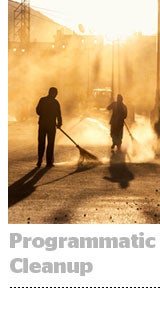This year’s theme was transparency. Marketers wanted transparency so they could make better decisions. Marketers, agencies and DSPs showed increased interest in the programmatic supply chain. They wanted to know the rules of programmatic auctions and the fees involved in advance, not find out hidden practices afterwards. They also wanted to know where to tread carefully to avoid exposure to ad fraud or bad ads.
Many ad tech leaders pushed for more transparency in digital advertising, seeing the benefit in demystifying and disinfecting the ad space once and for all.
Also in 2018, industry efforts to improve ad quality and protect marketers and publishers from fraud intensified.
Toward the end of the year, even the FBI got involved to prosecute ad fraud, giving the industry one more tool to fight bad actors.
Here’s a look back at how the ad tech ecosystem tried to clean up in 2018.
DSPs took hidden fees
Stressed by the rise in infrastructure costs due to header bidding, many DSPs looked at creative ways to fund their businesses.
Though DSP fees are generally considered more transparent than SSP fees because advertisers see exactly what they’re paying for, some DSPs extract money by asking for rebates if they look at more impressions, by pocketing discrepancy fees or creating supply partnerships. Plus, some buy-side platforms marked up data fees to advertisers.
Awareness around mobile app fraud
Running clean campaigns on mobile apps requires a different skillset than desktop and mobile web. And marketers became more versed on the nuances of the app world, such as how mobile app install fraud works, how mobile apps pass bad data and how in-app fraud differs from desktop fraud. Exposure of these practices gives marketers more ability to fight back.
Improving the ad experience
Certain ad formats – like forced mobile redirects, which cost publishers time and money – continue to frustrate consumers. But progress was made in other areas.
For instance, Google Chrome began blocking bad ad experiences in February to stop the intrusive ads that lead people to install ad blockers.
The fall of bid caching
How did a little-known Index Exchange rapidly gain market share and become a top partner of publishers? It cheated. Index secretly held higher bids for itself in order to win more inventory, a practice exposed by AdExchanger this summer. The company halted bid caching in August, and buyers withdrew from the platform. Then it got in trouble for how its wrapper favored itself.
Exposure of the nontransparent practice catalyzed change in the industry. Six top exchanges banded together and asked the Trustworthy Accountability Group to referee its auctions. The DSP MediaMath asked its supply partners to sign a document affirming it didn’t practice bid caching or game the auction in a host of other ways.
A look back at how Rocket Fuel mixed clients’ data
Mistakes were made. Data was stolen. AdExchanger’s look back at the one-time Wall Street darling confirmed what many smart advertisers had long suspected: Rocket Fuel stole client data and used it to feed its algorithm. People who browsed or bought products could be tempted to use products by a competitor instead.
FBI prosecutes ad fraud
The difficulties to charging people with ad fraud are manifold, but the FBI finally did it, charging eight people who earned millions by stealing advertising dollars from marketers. The industry rejoiced.
Ads.txt takes off
The ad industry worked hard in 2018 to close one of the loopholes used by the current cohort of ad fraudsters: domain spoofing. First introduced in May 2017, ads.txt released a proposal in June to address mobile apps, which it had revised by November. While the 3ve fraud operation was running wild and being monitored to build up a case, adoption of ads.txt thwarted one of its primary tactics to bring in revenue: domain spoofing.
The next step is already in the works. The revised openRTB 3.0 spec, released in July, opens the door for ads.cert, which will sign bid requests to prevent fraud. But not so fast – AdExchanger’s contributors warn that the fight isn’t over yet.














